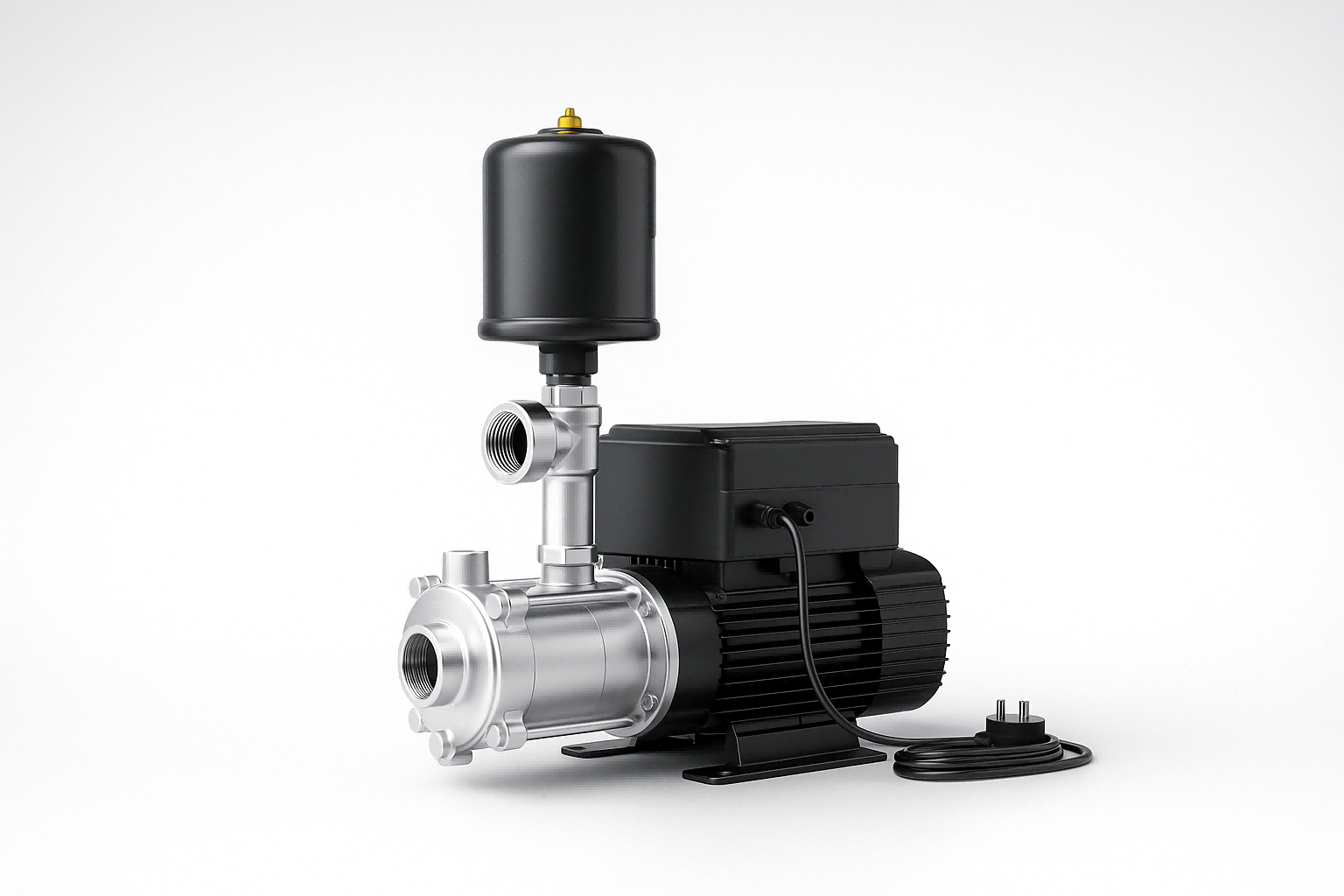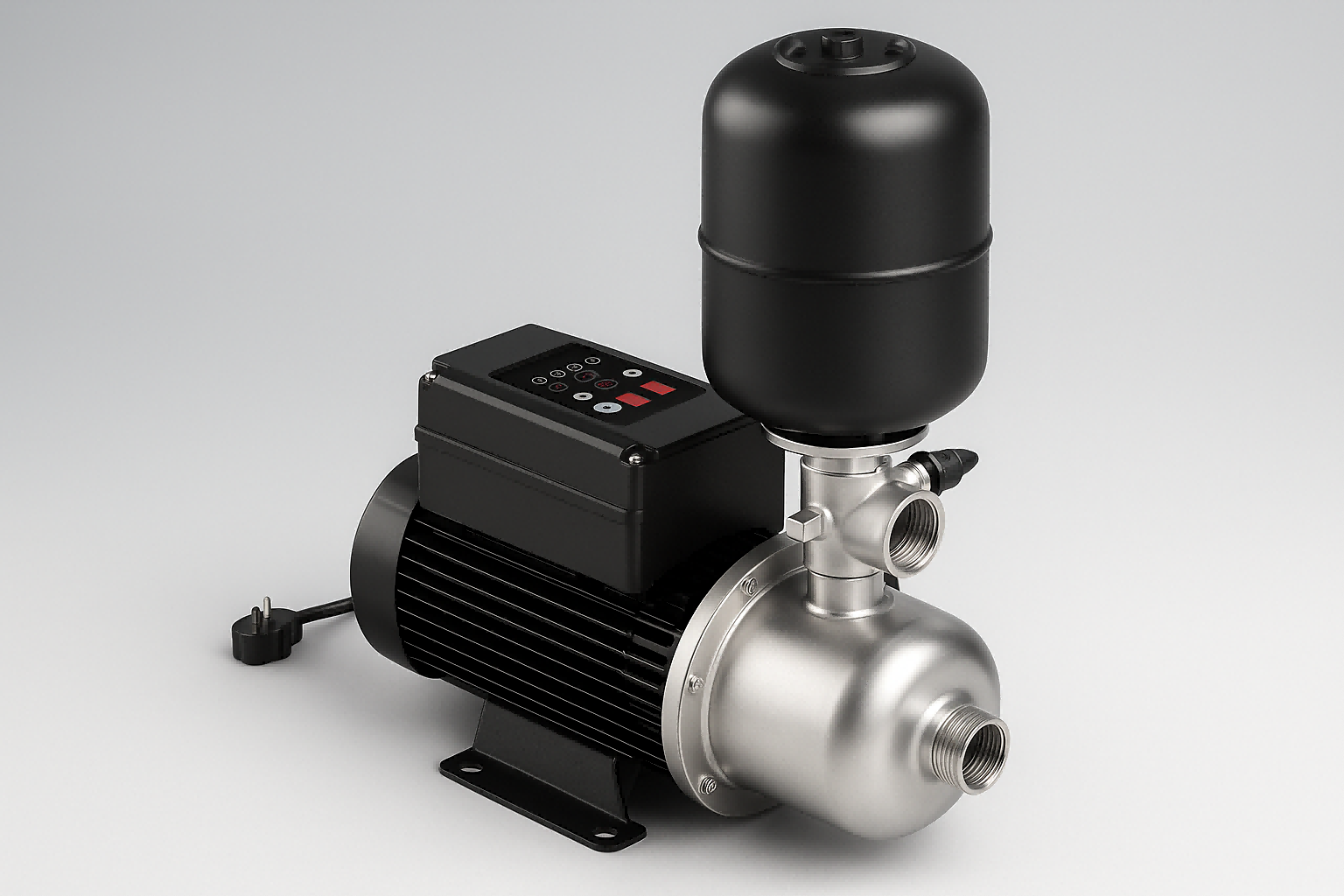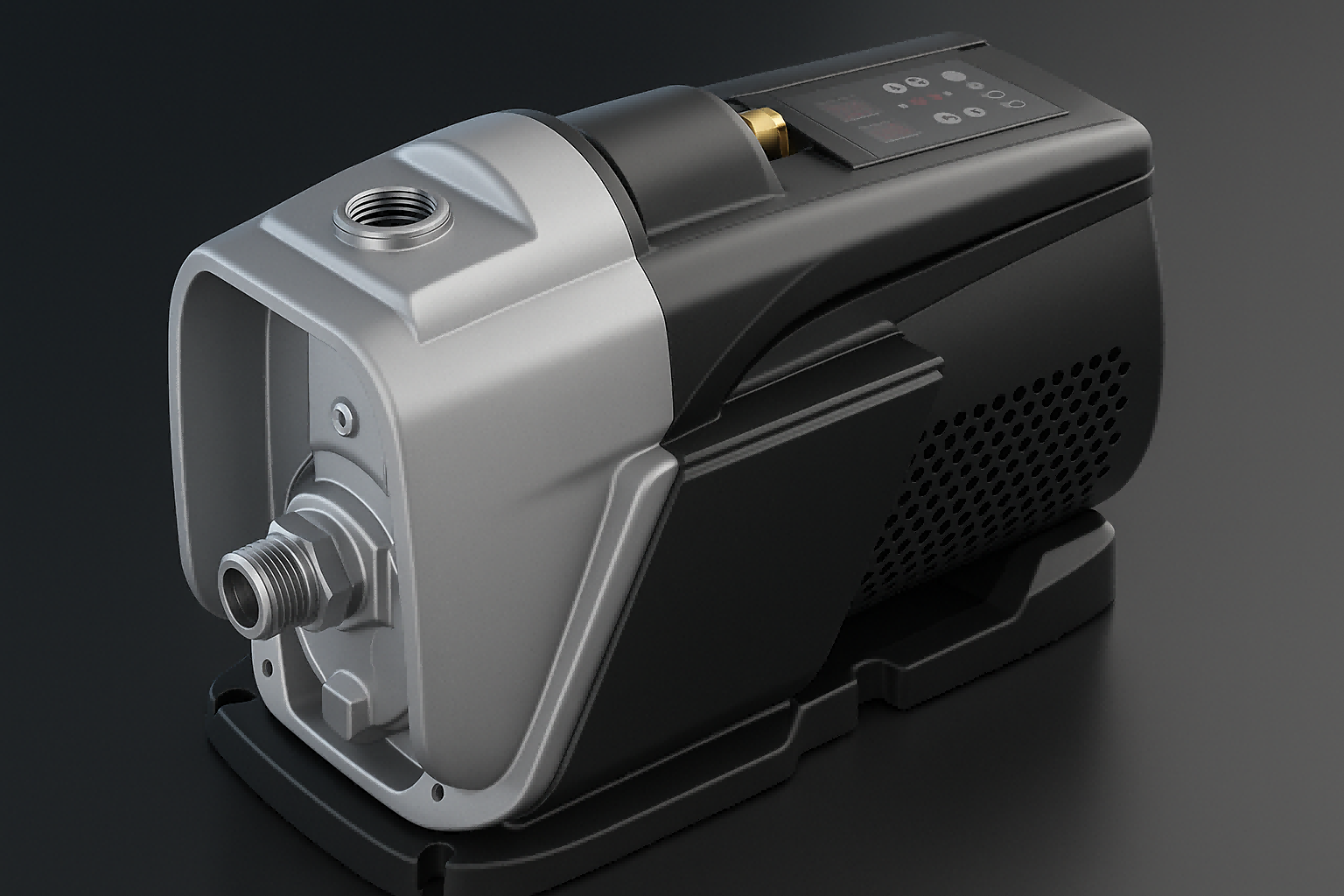What does a domestic water booster pump do?
Struggling with a shower that just trickles?
Low water pressure turns simple tasks into frustrating chores.
A booster pump is the powerful solution you need.
A domestic water booster pump is a device that increases low water pressure and flow throughout your home. It ensures you get a strong, consistent stream of water from every faucet, shower, and appliance, eliminating the frustration of a weak or fluctuating water supply.

This simple yet powerful device can completely transform your daily water usage experience.
But before you decide if a booster pump is right for you, it's essential to understand why you might have low water pressure in the first place.
Understanding the root cause will help you find the most effective and efficient solution for a powerful and reliable water supply in your home.
Let's explore the common reasons behind this widespread issue.
What causes low water pressure?
Wondering why your water flow is so weak?
It's a common household frustration that can disrupt your daily routine.
A few key issues, both inside and outside your home, are often the culprit.
Low water pressure can be caused by gravity, long distances from the water source, low municipal pressure, or extra water filtration systems. Internal plumbing problems, like hidden leaks or clogged pipes, are also common culprits that should be checked first.
Identifying the specific cause of your low water pressure is the first step toward finding the right solution.
Sometimes, a simple plumbing fix is all that's needed.
Other times, the problem is external and requires a more robust solution like a booster pump.
Let's dive deeper into these five common causes.
The Challenge of Gravity and Elevation
Gravity is a constant force affecting water flow.
If your home is located at a higher elevation than the water source, the water has to fight gravity to reach you.
This is especially true for multi-story homes or apartment buildings.
Water is heavy, weighing over eight pounds per gallon.
Pushing that weight uphill requires significant energy.
Each floor the water has to travel up decreases the pressure available at the tap.
This is why top-floor apartments often experience much weaker showers than ground-floor units.
A booster pump provides the necessary force to overcome gravity, ensuring that even the highest floors receive strong, consistent water pressure.
Distance and Pipe Size Matters
The journey water takes to your home also affects its pressure.
The farther your home is from the municipal water tower or pumping station, the more pressure is lost due to friction within the pipes.
If you live at the end of a long supply line, your pressure may be noticeably lower than that of homes closer to the source.
The diameter of the pipes plays a crucial role as well.
Smaller pipes create more resistance, restricting the volume of water that can flow through at any given time.
Think of it like trying to drink a thick milkshake through a narrow straw versus a wide one.
Upgrading pipe size is a major project, making a booster pump a much more practical solution for overcoming issues related to distance and existing pipe infrastructure.
When the City Supply is Low
Sometimes, the problem isn't with your home or its location at all.
Your local water utility may simply be supplying water at a low pressure to the entire neighborhood.
This can be due to aging infrastructure, high demand in the area, or water conservation policies.
In such cases, no amount of plumbing work within your home can solve the fundamental issue of a low-pressure supply.
Your neighbors are likely experiencing the same problem.
This is a perfect scenario for a water booster pump.
It takes the low-pressure water coming into your home and increases it to your desired level, giving you a powerful flow that your neighbors can only envy.
Added Systems and Plumbing Health
Modern homes often have additional water systems that enhance water quality, such as water softeners or whole-house filtration systems.
While these systems provide great benefits, they can also introduce resistance and cause a drop in water pressure.
Each filter and treatment medium the water must pass through slows it down.
However, before you assume an external factor is the cause, it's vital to check your home's plumbing health.
Clogged pipes, a partially closed main shutoff valve, or a malfunctioning pressure-reducing valve can mimic the symptoms of low external pressure.
Always have a plumber inspect your system for these internal issues before investing in a booster pump.
How does a booster pump work?
Tired of that weak shower spray?
A booster pump directly solves this by actively pushing water through your pipes.
Let's look at the simple, effective mechanics behind this powerful solution.
A booster pump works by using a motor to rapidly spin an internal component called an impeller. This spinning action pulls water in through an inlet and forces it out through an outlet with increased velocity and pressure, boosting your entire home's water supply.
The core principle is straightforward: the pump adds energy to the water.
Modern pumps have refined this process with advanced technology, making them more efficient, quieter, and more intelligent than ever before.
Let's explore the key components and advanced technologies that make today's booster pumps so effective.
The Core Components of a Modern Booster Pump
At the heart of every booster pump are a few key components working in unison.
- Motor: This is the power source. Advanced pumps use a Permanent Magnet Synchronous Motor (PMSM), which is highly efficient and operates with very little noise.
- Impeller(s): These are rotating discs with blades that spin at high speed. They transfer energy from the motor to the water, creating pressure.
- Inlet and Outlet: These are the ports where low-pressure water enters and high-pressure water exits the pump.
- Sensor and Controller: This is the brain of the system. It monitors pressure and flow, telling the motor when to turn on, how fast to run, and when to turn off.
The synergy between these parts determines the pump's overall performance and reliability.
Constant Pressure with Smart VFD Technology
Traditional pumps operate on a simple on/off switch, which can cause annoying pressure fluctuations.
Modern booster pumps use a Variable Frequency Drive (VFD) controller.
This sophisticated technology constantly monitors your home's water demand.
When you turn on a faucet, the VFD tells the motor to spin just fast enough to maintain your desired pressure.
If you open a second faucet, the VFD instantly increases the motor speed to keep the pressure perfectly stable.
This provides a true constant pressure experience, with no sudden drops or surges.
Additionally, VFD systems use a "soft start" and "soft stop" function.
This gradually ramps the motor speed up and down, which eliminates the hydraulic shock known as water hammer and significantly reduces mechanical stress on both the pump and your plumbing system.
The Balance Between Pressure and Flow Rate
It's important to understand the relationship between water pressure and flow rate.
Think about putting your thumb over the end of a garden hose.
The water sprays out with higher pressure, but the total amount of water coming out (the flow rate) is restricted.
A booster pump works to optimize this relationship for your home.
It provides the necessary pressure to move water efficiently through your pipes, even uphill and around bends.
While the pump increases pressure, the flow rate is ultimately limited by the size of your pipes.
An expertly sized pump provides the best possible flow rate at the ideal pressure for your specific plumbing system, ensuring all your fixtures operate powerfully and efficiently without straining the pipes.
What are the different types of booster pumps?
Choosing a booster pump can seem complex.
There are many options available on the market.
However, the choice really comes down to your specific needs and the scale of your application.
Booster pumps are primarily categorized as single-stage for smaller homes or multi-stage for high-pressure needs like multi-story buildings. Modern pumps also feature intelligent VFD controls, which offer superior efficiency, constant pressure, and enhanced system protection.
Understanding these basic categories will empower you to select a pump that not only solves your low-pressure problems but also operates efficiently and reliably for years.
Let's break down the key differences and explore the advantages of the latest pump technologies.
Single-Stage vs. Multi-Stage Pumps
The fundamental difference between these types is the number of impellers they use.
-
Single-Stage Pumps: These pumps have just one impeller. They are excellent for providing a significant pressure boost in smaller applications, such as a single-story home or for a specific piece of equipment. They are generally more compact and cost-effective.
-
Multi-Stage Pumps: These pumps have two or more impellers that work in a series. Each stage increases the pressure further. This design makes them ideal for applications requiring very high pressure, such as sending water to the top floors of a tall apartment building, commercial complexes, or long-distance irrigation systems.
The choice depends entirely on how much pressure you need to add to your system.
The Rise of Smart VFD Pumps
The most significant advancement in recent years is the integration of Variable Frequency Drive (VFD) technology.
These "smart pumps" represent a major leap forward in performance and efficiency.
Instead of running at full speed all the time, a VFD pump adjusts its motor speed in real-time based on water demand.
This intelligent control delivers several key benefits:
- Energy Savings: By using only the power needed at any given moment, VFD pumps can drastically reduce electricity consumption compared to fixed-speed pumps.
- Constant Pressure: They eliminate frustrating pressure fluctuations, providing a steady and comfortable flow whether one faucet is open or several are.
- Ultra-Quiet Operation: The efficient motors and optimized speed control result in extremely quiet performance, often operating at a noise level below that of a quiet library.
- Wide Voltage Adaptability: High-quality VFD pumps can operate flawlessly even in areas with unstable power grids, handling a wide range of input voltages without performance loss.
The Importance of an Expansion Tank
Many high-quality booster pump systems incorporate a small pressure tank, also known as an expansion or hydropneumatic tank.
This component, while simple, plays a crucial role in system efficiency and longevity.
The tank contains a small reservoir of pressurized water.
When you open a faucet for a very short time (like rinsing your hands), the tank supplies the water without the pump needing to turn on.
This simple action can reduce the number of times the pump needs to start and stop by as much as 70%.
Fewer cycles mean less wear and tear on the motor and electrical components, significantly extending the pump's lifespan.
Furthermore, the tank helps absorb pressure surges in the system, preventing the damaging effect of water hammer and protecting your plumbing and appliances.
How do you choose the right booster pump?
Worried about picking the wrong pump for your home?
It's a valid concern, as the wrong choice can lead to poor performance or even damage.
Asking the right questions upfront ensures you get the perfect fit for your home's unique needs.
To choose the right booster pump, you must first calculate your required flow rate and determine the necessary pressure boost. You also need to consider your water source's location, the quality of pump materials, and the available safety features.
Sizing a booster pump correctly is a critical step that balances performance, efficiency, and cost.
It’s not just about buying the most powerful pump; it’s about buying the smartest one for your situation.
Let's walk through the key factors you need to evaluate.
Sizing Your Pump: Key Questions to Ask
Before you shop, you need to gather some information about your home's water system.
- What is my required flow rate? You need to know the maximum amount of water your household might use at one time. You can estimate this by adding up the flow rates of your fixtures.
| Fixture | Typical Flow Rate (Gallons Per Minute) |
|---|---|
| Kitchen Faucet | 1.5 - 2.2 GPM |
| Bathroom Faucet | 1.0 - 1.5 GPM |
| Shower Head | 1.5 - 2.5 GPM |
| Dishwasher | 2.0 - 4.0 GPM |
| Washing Machine | 2.0 - 5.0 GPM |
-
How much pressure do I need? Most homes operate best between 45 and 60 PSI. Measure your current pressure to know how much of a "boost" you need. Pressure that's too high (over 80 PSI) can damage your plumbing.
-
Where is my water source? Is the pump moving water from a storage tank below, or is it boosting pressure from the city main? This affects the type of pump and horsepower required.
Material Quality and Durability
The lifespan and reliability of a booster pump depend heavily on the materials used in its construction.
Look for pumps that prioritize high-quality components.
- Impellers: Impellers made from AISI304 stainless steel or high-grade brass offer excellent resistance to corrosion and wear, ensuring long-term performance.
- Housing: A robust housing, often made from UV-resistant ABS plastic or cast iron, protects the internal components from the elements and physical damage.
- Bearings: The use of premium bearings from reputable manufacturers is a critical detail. High-precision bearings lead to quieter operation, less vibration, and a significantly longer motor lifespan.
- Cooling System: An efficient cooling design is vital for motor longevity. Look for pumps with enhanced airflow and heat dissipation features, which prevent overheating under continuous use.
Advanced Protection Features to Look For
A truly reliable booster pump is one that can protect itself from common problems.
Modern, intelligent pumps come equipped with a comprehensive suite of built-in safety features.
These protections are crucial for ensuring a long, trouble-free operational life.
Key features to look for include:
- Dry Run Protection: This is one of the most important features. It automatically shuts the pump off if it detects a water shortage, preventing the motor from burning out.
- Overheating Protection: Sensors monitor the temperature of the motor and the electronics, shutting the system down if it gets too hot.
- Voltage Protection: The pump safeguards itself against damage from power surges or low voltage from the electrical grid.
- Antifreeze Protection: In colder climates, this feature will periodically run the pump for a few seconds to prevent water inside from freezing and cracking the housing.
- Leak Detection: Some advanced systems can detect small, continuous flows characteristic of a leak in your plumbing and will alert you to the problem.
- Waterproof Electronics: Look for pumps where the main controller board is sealed (potted) in a waterproof compound. This achieves a high IP rating (like IP67) and protects the sensitive electronics from moisture and condensation, which is a leading cause of failure.
What are the best practices for installation?
A great pump can still cause problems if it's not installed correctly.
Annoying noises and premature failures are common results of a poor setup.
Let's cover the essential best practices to ensure your new pump works perfectly from day one.
For a successful booster pump installation, place it on the main water line, always install a bypass loop for future maintenance, and use flexible connectors on the inlet and outlet pipes to absorb vibration and minimize noise.
Following these professional guidelines will not only make your system quieter and more reliable but will also make any future servicing much simpler.
Proper installation is just as important as choosing the right pump.
Let's dive deeper into these critical steps.
Finding the Right Location
The placement of your booster pump is the first crucial decision.
It should be installed on the main water line where it enters your house.
This is typically located in a basement, crawl space, or utility closet.
The correct order of installation is: Main Shutoff Valve -> Water Meter -> Booster Pump.
Placing the pump here ensures that the pressure is boosted for the entire house, distributing the benefit to every single fixture.
Ensure the location is accessible for future maintenance and is protected from freezing temperatures if you live in a cold climate.
Why a Bypass Loop is Non-Negotiable
A bypass loop is a secondary plumbing arrangement that allows water to flow around the booster pump.
It consists of a parallel pipe and a few extra valves.
While it adds a small cost to the installation, it is an absolutely essential feature.
If your pump ever needs to be repaired, serviced, or replaced, you can simply close the valves leading to the pump and open the valve on the bypass loop.
This isolates the pump from the system while allowing water (at its original low pressure) to continue flowing to your house.
Without a bypass, you would have to shut off the water to your entire home for the duration of the repair, which could be hours or even days.
It's a small step that provides immense convenience and peace of mind.
Keeping Your Booster Pump Quiet
One of the biggest complaints about older booster pumps is the noise and vibration they create.
While modern pumps are designed to be extremely quiet, proper installation is key to preventing noise transmission through your plumbing.
Never connect the pump's inlet and outlet directly to rigid pipes like copper.
The pump's natural vibration, no matter how small, will be amplified by the rigid pipes and can create a loud humming or buzzing sound throughout your house.
The solution is to use flexible, braided steel water connectors on both the inlet and the outlet.
These connectors are designed to absorb vibration, isolating the pump from the rest of the plumbing system and ensuring a whisper-quiet operation.
Testing and Commissioning
After the pump is fully installed, don't just turn it on and walk away.
You need to properly test and commission the system.
First, slowly open the valves to let water fill the pump and the lines, bleeding out any trapped air.
Then, turn on the pump and check the pressure gauge to ensure it's set to your desired level (typically 50-60 PSI).
Most importantly, carefully inspect every joint and connection for leaks.
Even a tiny, slow drip can cause a pressure-activated pump to cycle on and off frequently.
This constant cycling will cause premature wear and dramatically shorten the pump's lifespan.
Take the time to ensure the system is completely watertight before considering the job finished.
Conclusion
A domestic water booster pump is the key to solving chronic low water pressure.
Choosing a quality, intelligent model and ensuring it is installed correctly guarantees a powerful, reliable, and comfortable water supply for years to come.
FAQs
Do I always need a booster pump for low pressure?
Not always. First, check for leaks, clogged pipes, or a partially closed main valve. A plumber can best diagnose the true cause.
Are water booster pumps noisy?
Modern pumps, especially those with variable speed drives, are designed for very quiet operation, often producing less noise than a refrigerator.
How long does a booster pump last?
A quality booster pump with advanced protective features can last 8 to 15 years with proper installation and routine maintenance.
Can a booster pump save me money?
Yes. Intelligent variable speed pumps only use the energy needed to meet demand, which can significantly reduce your electricity bills compared to older pumps.
Can a booster pump be too powerful?
Yes, excessive pressure can damage pipes and appliances. A properly sized system maintains pressure within a safe range, typically below 80 PSI.
Where is the best place to install a booster pump?
It should be installed on the main water line where it enters your house, after the water meter but before the line splits off.
Does a booster pump increase water volume?
It increases the flow rate (volume over time) by boosting pressure. However, it's limited by the maximum volume your main supply line can provide.
What maintenance does a booster pump require?
Most modern pumps require very little maintenance. It's good practice to periodically check for leaks and ensure intake screens are clear of debris.








